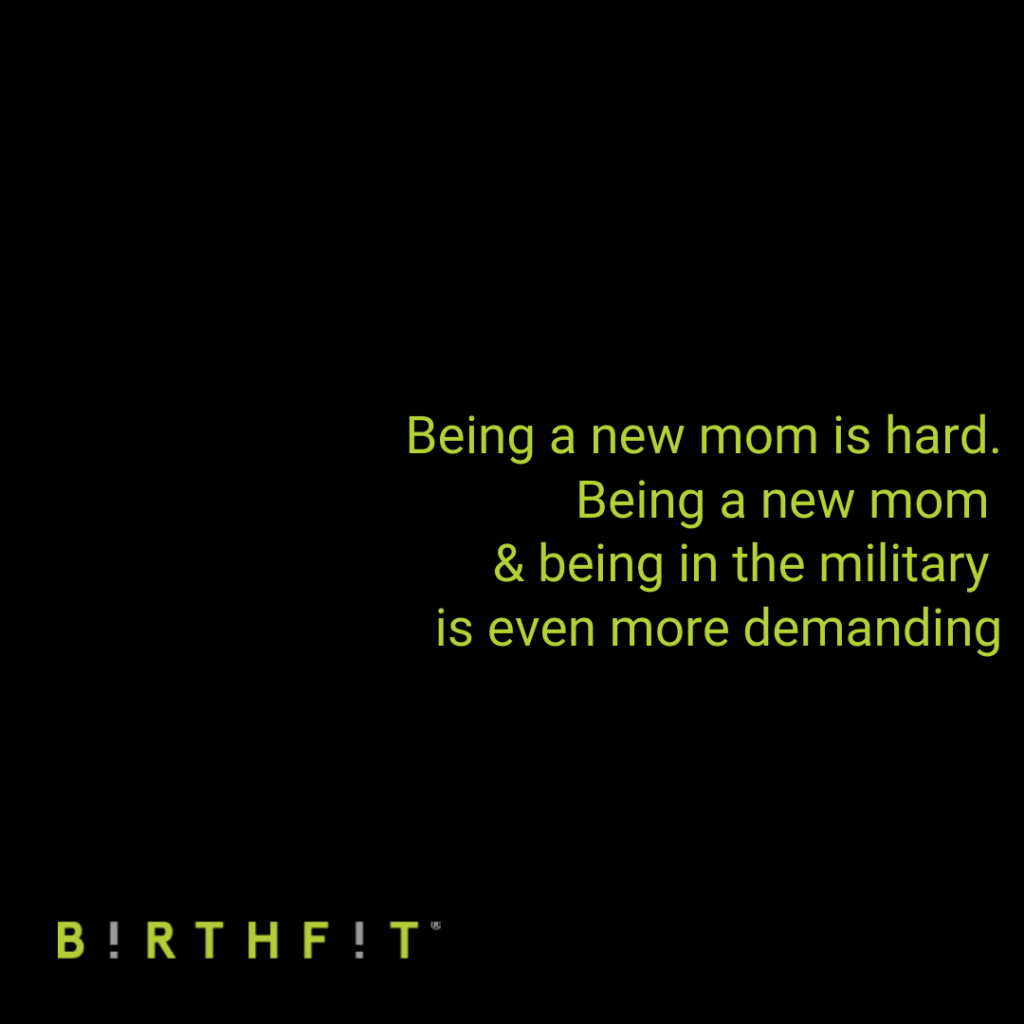This post first appeared on the BIRTHFIT Blog

Being a new mom is hard. Being a new mom and being in the military is even more demanding. Over the past few years, the military has made strides in maternity leave, operational deferments, and breastfeeding policy. One area that many active duty moms still find frustrating, though, is returning back to weight and fitness standards after giving birth. Depending on the service branch, new moms are given somewhere between 180 days and 18 months to meet standards. Even the fitness and weight standards vary by service. Only one service provides a postpartum fitness program, but I found that it was designed in a way that would push the body too hard, too soon. It also did not address the recovery and healing required by the body. With the timelines and standards as they are today, moms can still arm themselves with the tools to make healing and recovery a priority when preparing for the first postpartum physical fitness test.
- Eat.
Eat food. Aim for nutrient-dense foods and eat an adequate number of calories. Don’t feel so pressured to lose weight that you drastically cut calories, as this may also result in a drop in your breastmilk supply. According to KellyMom.com, “Studies have shown that most healthy breastfeeding women maintain an abundant milk supply while taking in 1800-2200 (or more) calories per day. Consuming less than 1500-1800 calories per day (most women should stay at the high end of this range) may put your milk supply at risk, as may a sudden drop in caloric intake.”1 This 1800-2200 calorie mark should serve as a baseline! The more active you are, the more calories you will need to consume to maintain your milk supply.
Carbohydrate intake is also important. In her book Real Food for Pregnancy, Lilly Nichols recommends that moms with a well-established supply eat at least 50 carbs a day.2 If you are concerned about weight loss and want to cut carbs, slowly taper down while monitoring your milk supply. If your supply drops, up your intake. If you are highly concerned about your weight, reach out to your PCM to get your labs checked and discuss if you can get a referral to a registered dietitian. Bottom line: NOURISHING your body with your food intake, and your baby through breastmilk (if that is the route you have chosen), is more important than losing weight quickly. Your body has changed. It’s okay to slowly transition back to your weight standards and pre-pregnancy uniforms. Take the pressure off when you initially return to work and get bigger working uniforms for those first few months back. The base thrift store is a great place to find some. Prioritize making smart choices and gradually lose weight while keeping up your milk supply.
- See a Pelvic Floor Physical Therapist (PFPT).
An evaluation by a PFPT should be a standard postpartum care practice. While not standard, it is available to all active duty members and dependents. TRICARE often covers these visits. You can get a referral from your OB/MIDWIFE at your postpartum check-up or through your PCM. Whether you’ve had a c-section or vaginal birth, your pelvic floor has borne the weight of pregnancy for nine months. A PFPT will conduct an internal exam to determine the status of your pelvic floor. They will then work with you to develop a strong, functional pelvic floor. It is very important to be evaluated prior to starting high impact activities, such as running or HIIT workouts. Research shows that it can take a FULL YEAR for the pelvic floor function to return to its pre-pregnancy baseline, and even longer if there is a return to high-intensity activities too soon!3 Peeing when you jump or run, or having pain during sex, is not normal. If you have these symptoms, schedule a consult with pelvic floor PT and have your pelvic floor evaluated.
- Check for and Let Heal Your Diastasis Recti.
Diastasis Rectus Abdominis (DRA) is the separation of the rectus abdominis muscles (commonly referred to as the six-pack) beyond a normal distance, and it happens during 100% of pregnancies4. DRA is measured in finger widths and depth. You can seek out a BIRTHFIT Leader to evaluate your DRA or learn to check it yourself.
So How do You Heal DRA?
- The first way is via breath. Diaphragmatic breathing uses all aspects of the abdomen, includes the pelvic floor, and strengthens and stabilizes the core. In pregnancy, and in general, we become chest breathers. Retraining ourselves to breathe with our diaphragm may be a lot of work, but it comes with huge benefits. Besides stabilizing your core, diaphragmatic breathing also reduces stress, lowers blood pressure, and regulates the body systems.
- Avoid movements that cause coning or that put pressure on the linea alba. Ideally, for the first 12 months postpartum you want to avoid crunches, sit-ups, extended planking, toes to bar (including the modification of knees to elbows), mountain climbers, v-ups, kipping, and L-sits. In addition, until you have developed a stable core and pelvic floor (at least 12-16 weeks postpartum) you want to avoid burpees, jump rope (double or single-unders), running, and box jumps.
- Move using functional movements that mimic normal childhood development. FUN FACT: All babies are born with DRA! BIRTHFIT FUNCTIONAL PROGRESSIONS are purposeful movements that mimic childhood developmental patterns that will help strengthen and stabilize your core.
- Slow down.
SLOW IS FAST. Say that one more time. SLOW IS FAST. Also, POSTPARTUM IS FOREVER. Say that one again too. I know this runs counter to the timelines the military puts on us, but we still need to slow things down and be intentional to let our bodies heal! We need to respect the whole first year of postpartum to allow our bodies to properly HEAL, RECOVER, and REBUILD.
I think some planning is beneficial here. Look at your service’s physical fitness test, weight standards, and the timeline for when you need to meet them. Know the minimum numbers you have to meet for physical fitness tests, and the maximum times/weights for them. Also know the impact to evaluations (if any), if you score at or close to the minimums vs. maxing everything out. Perhaps, instead of focusing on maxing out your scores, why not shoot for the middle (or lower), since you may not be able to adequately train for certain events until closer to the deadline. Assess what you need to do to get to the level you need to be at to pass. Assess where you need to be at six months and twelve months postpartum to ensure you stay on track to meet these goals. Assess your priorities and goals. If losing weight runs counter to breastfeeding, but breastfeeding is your priority, maybe it makes more sense to aim for the lower end and getting taped (Navy/Coast Guard) vice making weight. Think hard about what your true goals are and reassess your desire to be the best with all the other points considered. It is 100% okay to not max out on all the tests your first time postpartum. You will have time to recover and prepare for the next one, and you will be better suited to do so, if you slow down and let your body more fully heal before the first one!
- Build Community
The most unexpected thing that can come from the motherhood transition is community. The connection we build with fellow military moms ahead and behind us is invaluable. Our community passes along uniforms, gives advice, helps us navigate the instructions and regulations, and helps us find our voice when bringing issues and concerns up with our commands.
I charge you to create that supportive community that encourages other new mamas to take it slow and educate them on how to navigate the ropes of motherhood in the military. Community can be found within your commands or bases, in online groups, and through other avenues. Find other mamas preparing for their first PRT and work together to build strong and healthy bodies! Your community is invaluable, especially as you navigate the hurdles and postpartum challenges the military brings, like preparing for a physical fitness test.
- Be the Voice of Change
You can make a change. Educate each other, fill out surveys, route feedback up your chain of command, or ask questions when you have Q&A sessions with your command or service’s head. Tell them that the Armed Forces need adequate postpartum fitness programs that focus, first and foremost, on healing the body, while sensibly rebuilding it to meet standards. Present them evidence and explain why they should not rush postpartum moms into PT or weight tests and explain that waiting at least one year, or more reasonably 15-18 months, will allow for a stronger female workforce going forward. The military needs healthy, strong, fit, and ready warriors, and this is one of the best ways to ensure they will be there after preparing for the first postpartum physical fitness test!
- https://kellymom.com/nutrition/mothers-diet/mom-calories-fluids/
- Nichols, Lily. Real Food for Pregnancy. Page 227. 2018
- Elenskai, Ksena, et al. “The effect of pregnancy and childbirth on pelvic floor muscle fucntion.” Interaltional Urogynecology journal 22.22 (2011):1421
- Mota P, Pascoal AG, Carita AI, et al. Prevalence and risk factors of diastasis recti abdominis from late pregnancy to 6 months postpartum, and relationship with lumbo-pelvic pain. Man Ther 2015;20:200–5. https://www.ncbi.nlm.nih.gov/pubmed/25282439
Need help navigating this time? I am available for 1 on 1 consultations and group postpartum classes. Click here to see all my offerings.

